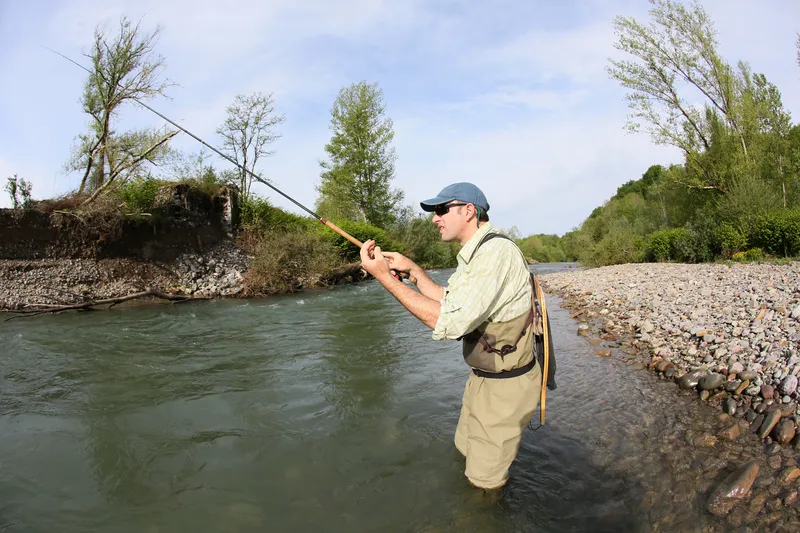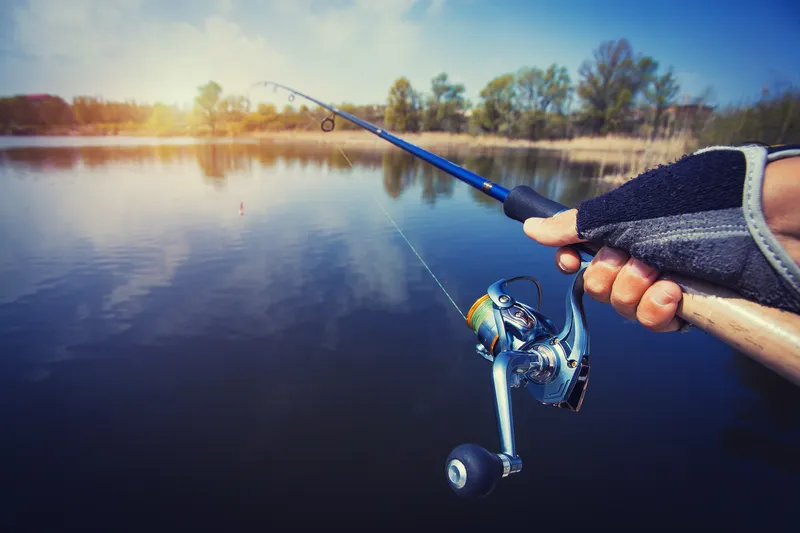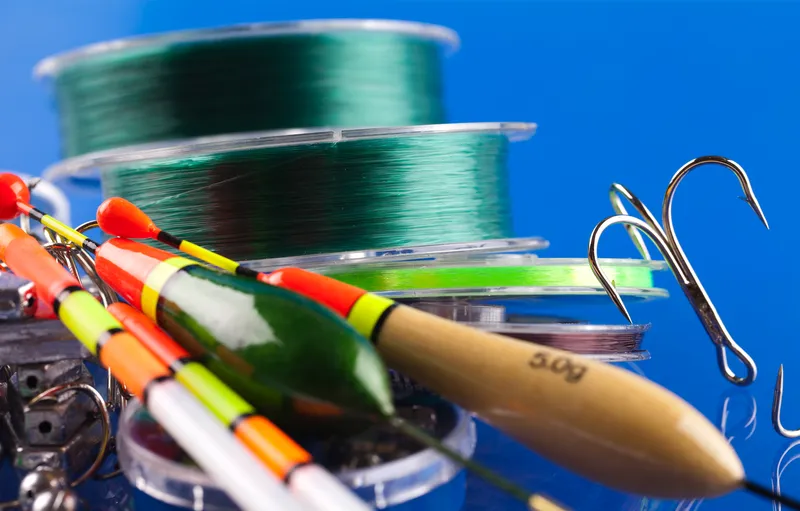Fishing enthusiasts understand the importance of choosing the right equipment, as it can mean the difference between a successful or unsuccessful catch. One of the most important, yet often overlooked, pieces of equipment is fishing line.

The wrong line can result in lost fish, frustration and even wasted time and money. This guide will help buyers make an informed decision when it comes to selecting the right fishing line for bass fishing.
The Importance Of Choosing The Right Fishing Line For Bass Fishing
When it comes to bass fishing specifically, choosing the right line is crucial for success. Bass are known to be strong fighters and will put up a fight when hooked. A good quality line that is specifically designed for bass fishing will have greater tensile strength, meaning that it is less likely to snap when under stress.
The correct fishing line will also provide enhanced sensitivity so that anglers can feel even the slightest nibbles or bites. This allows them to set the hook quickly and accurately without giving fish too much time to escape.
How This Guide Will Help Buyers Make An Informed Decision
With so many different types and brands of fishing lines available on the market, selecting one can be overwhelming. This guide will provide buyers with helpful information on each type of line that is suitable for bass fishing along with their strengths and weaknesses. This guide will also provide guidance on how to choose the appropriate strength and diameter based on factors such as fish size and weight.
Additionally, readers will learn about stretch versus sensitivity in a fishing line as well as color selection based on water clarity. By providing all this information in one place, readers can make an informed decision when purchasing their next bass-fishing line.
Types Of Fishing Line
Fishing lines come in different types, sizes, colors, and materials. Selecting the right type of fishing line is key to a successful fishing experience. The three main types of fishing lines available are monofilament, fluorocarbon, and braided lines.
Monofilament Lines
Monofilament lines are a popular choice for many anglers due to their versatility and affordability. Made from a single strand of nylon or similar material, these lines are known for their stretchability and shock resistance.
They provide the angler with enough time to set the hook when a fish bites. One drawback of monofilament lines is that they tend to deteriorate easily over time due to exposure to UV light and water absorption.
As such, it is essential to replace them regularly. They also have high visibility levels in water due to their reflective properties that could spook some fish species.
Fluorocarbon Lines
Fluorocarbon lines have become increasingly popular among anglers in recent years because they are virtually invisible underwater compared to monofilament or braided lines. Furthermore, this line type is denser than water making it sink faster compared to other types which can be an advantage when targeting deep-lying fish species like bass. Fluorocarbon has lower stretchability compared to monofilament line which can be useful when trying to feel every bite on your bait or lure with more sensitivity; however, it also means that there’s less shock absorption reducing its ability as a shock leader or if you are using heavy lures.
Braided Lines
Braided fishing line is made from several strands of synthetic fibers woven together creating exceptional strength for its diameter while offering zero stretch characteristics making them ideal for targeting big bass species that require a lot of brute force while reeling in. The no-stretch feature also enables anglers to feel the slightest movement on their bait or lure, making it easier to detect bites.
One disadvantage of braided lines is that they are highly visible underwater, especially when compared to fluorocarbon lines, which can be a disadvantage when targeting bass in clear water. Additionally, braid has a lower abrasion resistance than fluorocarbon or monofilament line.
Choosing The Best Type Of Line For Bass Fishing
No products found.
Choosing the best type of line for bass fishing depends on several factors such as the type of water you’re fishing in, the size and weight of your lures/baits, and personal preferences. For instance, if you’re fishing in deep water or using heavy lures that require more force to reel in, then braided lines may be the better option. If you’re looking for a more versatile and affordable option with some stretchability for shock absorption when setting hooks on smaller soft-mouthed fish species like Largemouth Bass; then monofilament might be suitable whereas fluorocarbon’s exceptional sensitivity and invisibility underwater make it great for finesse presentations like drop-shotting or jigging techniques around heavy cover where stealthy approach is crucial.
Line Strength And Diameterchoosing The Right Line Strength And Diameter Based On The Size And Weight Of Bass Being Targeted
When choosing a fishing line for bass, one important factor to consider is line strength. Line strength refers to the amount of weight a line can withstand before it breaks.
A higher line strength is necessary when targeting larger, heavier fish such as big bass. The size and weight of the bass being targeted will determine how strong the line needs to be.
It’s recommended that anglers choose a fishing line with a breaking strength between 10-20 pounds for catching bass. However, if you’re targeting larger bass in deep water or heavy cover, you may need to use a stronger fishing line with a breaking strength between 30-50 pounds.
When selecting your fishing line, it’s essential to match your rod and reel’s power rating as well. The power rating of your rod will indicate its ability to handle different types of lures and bait. Examples Provided to Illustrate this Point
For example, if you’re using topwater lures or finesse baits for smallmouth or largemouth bass in open water conditions with moderate depth, an 8-12 lb monofilament fishing line is ideal for casting distance but still strong enough for most fish under 5 lbs. On the other hand, if you’re going after trophy-sized largemouths that weigh over 5 lbs in dense weeds or rocky areas where they try to break free from snags or underwater structures like trees/rocks underwater that provide shelter/cover from predators such as pike muskies etc., then choose braided lines ranging from 40-65 lb test depending on conditions. When selecting your fishing equipment’s diameter (thickness), remember that thinner diameter lines have less resistance in water but are weaker than thicker ones.
Thicker diameter lines have more resistance but are stronger. This is important when choosing line strength, as thicker lines can handle more weight but may be visible in clear water and may not be suitable for finesse fishing techniques.
Choosing the right line strength and diameter requires balancing a variety of factors to ensure success. By considering the size and weight of bass being targeted, selecting the appropriate breaking strength, and matching your rod’s power rating, anglers can select a durable fishing line that will help them hook their dream bass.
Stretch Vs Sensitivity:

The stretch and sensitivity of a fishing line play a crucial role in determining how well an angler can detect and hook a fish. Stretch refers to the amount of give in the line when it is under tension, while sensitivity refers to how easily the angler can feel vibrations or movements through the line.
A fishing line with too much stretch may make it difficult to detect bites, whereas one with too little stretch could lead to hooks being ripped out of the fish’s mouth. Similarly, if a line is not sensitive enough, an angler may not be able to feel when a fish is biting or when they are dragging their bait across underwater structures.
Monofilament Lines:
Monofilament lines are known for their high stretchability and shock resistance properties. They have excellent knot strength and are relatively affordable compared to other types of lines.
Monofilament lines offer good sensitivity but are usually preferred for their ability to absorb shocks from fighting fish without breaking. While they may not be as sensitive as other types of lines, monofilament lines still provide enough feedback for anglers to detect bites.
Fluorocarbon Lines:
Fluorocarbon lines have low visibility underwater and are almost invisible in water due to their refractive index being similar to that of water. They offer excellent sensitivity because they transmit vibrations more efficiently than monofilament lines do.
No products found.
Their low stretchability makes them ideal for fishing in deep waters since anglers can feel even faint bites and make quick responses resulting in better hook sets. Fluorocarbon lines also have high abrasion resistance against underwater structures such as rocks and logs making them ideal for rocky areas where bass often hide.
Braided Lines:
Braided fishing lines have little to no stretch, making them extremely sensitive and ideal for bass fishing. Anglers can feel even the slightest bites or movements in the line, giving them an edge in detecting bites and setting the hook quickly. Braided lines also have a small diameter while maintaining high strength, which allows for longer casts with less effort.
However, braided lines are not as abrasion resistant as fluorocarbon lines and may snap when rubbed against underwater structures. They are also more visible to fish than monofilament or fluorocarbon lines which may make it hard to catch wary bass that are heavily fished.
Recommendation:
The best type of fishing line for bass fishing depends on various factors such as water clarity, structure, weather conditions, and personal preference. However, fluorocarbon and braided lines are often preferred due to their low stretchability and exceptional sensitivity properties that make detecting bites much easier.
Fluorocarbon is ideal for clear water conditions where visibility is a factor while braided line works well in heavy cover areas. When selecting a fishing line for bass fishing it’s important to consider all factors including the type of bait you will be using since different types of baits require specific types of fishing lines to achieve optimal results.
Color Selection: The Importance Of Choosing The Right Color
Selecting the right color for your bass fishing line can make all the difference in your success on the water. Fish are visual creatures, and they use their eyesight to hunt for prey.
Selecting a color that is more visible in the water can increase your chances of catching a bass. On the other hand, if you select a color that blends in with the surrounding environment, you may have a harder time getting bites.
Overview Of Popular Color Options For Bass Fishing Lines
There are many different colors available when it comes to selecting a fishing line, but some colors have proven to be more effective than others when targeting bass. One popular color option is green, which tends to blend in well with vegetation and mimic natural surroundings where bass often reside. Another popular option is clear or transparent line, which can be useful in clear water where fish might be spooked by bright or opaque colors.
In addition to solid colors, many fishing lines come in multi-color options as well. These lines change colors every few feet or yards and help anglers track how deep their lures are diving and where fish might be located based on depth.
Tips For Selecting Colors Based On Water Clarity
Water clarity plays a significant role when it comes to selecting an effective color for your bass fishing line. For example, if you’re fishing in murky or stained water, darker colored lines like black or dark green may be more visible to fish than lighter colored options like white or yellow. In contrast, if you’re fishing in clear water conditions, it’s essential to choose a lighter colored line that blends into the natural environment.
Another factor to consider is time of day – darker lines may work better during low-light conditions before sunrise and after sunset while lighter-colored lines could work better during mid-day and bright, sunny conditions. Ultimately, the best way to determine what color works best is by experimenting with different options under varying conditions to see what works best for you.
Durability And Cost

Discussion On How Durability Impacts Cost Effectiveness Over Time
When selecting a fishing line for bass, it is important to consider the durability of the line. A durable fishing line will save money over time by reducing the need to replace it frequently. The most durable lines are typically braided lines, which are made from woven strands of material that provide strength and abrasion resistance.
Braided lines are also resistant to UV rays and chemicals, making them ideal for long-term use. Monofilament and fluorocarbon lines can be less durable than braided lines due to their tendency to wear down or become damaged more quickly.
Monofilament can degrade when exposed to sunlight or chemicals, so it is important to store it properly in order to maximize its lifespan. Fluorocarbon is generally more resistant than monofilament but still not as strong as braided lines.
Explanation On How To Balance Cost With Durability When Selecting A Fishing Line
When considering cost effectiveness, it is important not only to look at the initial price of the fishing line but also its longevity. A cheaper line may seem like a good deal initially, but it may not last as long as a more expensive and durable option.
No products found.
Conversely, an expensive fishing line may have great reviews but might not be worth the investment if you only fish occasionally. A good way to balance cost with durability when selecting a fishing line is by considering your own individual needs and budget. After checking out this article, read How Long Does Fishing Line Last?
If you fish regularly or in rough conditions, investing in a higher quality braided line may be worth the initial expense for its longer lifespan. However, if you only fish occasionally or in calm waters, a lower-priced monofilament or fluorocarbon may suffice.
Another way to balance cost with durability when selecting a fishing line is by comparing prices across different brands and material types before making your final decision. Some brands may offer more affordable options without sacrificing durability, while others may prioritize quality over affordability.
A Creative Subtitle
When selecting a fishing line for bass, it is important to consider the balance between cost and durability. While investing in a more expensive braided line may seem daunting at first, its longevity and resistance to damage make it a smart long-term investment.
On the other hand, a lower-priced monofilament or fluorocarbon may be suitable for occasional use or less demanding conditions. By doing your research and comparing prices across different brands and types of fishing lines, you can find the best option that meets both your budget and performance needs.
Frequently Asked Questions
Selecting the right bass fishing line depends on various factors, including the fishing conditions, the type of bait, and the technique used. Factors like line material, diameter, and strength are also important to consider.
Mike Iaconelli is still an active professional angler, television host, and author. He has won several major tournaments throughout his career and is a well-known personality in the bass fishing community.
The choice of fishing line varies among professional bass fishermen, and there is no one-size-fits-all solution. However, fluorocarbon and braided lines are popular choices due to their sensitivity, strength, and low visibility.
Braided line is the most versatile bass fishing line, as it offers a high strength-to-diameter ratio, minimal stretch, and excellent sensitivity. It is suitable for various fishing techniques and can be used in different water conditions.
The best color line for bass fishing depends on the water clarity and the weather conditions. Generally, clear or low-visibility lines like green, clear blue, or smoke are good options for clear water, while hi-vis or fluorescent colors like yellow or orange are more visible in murky water or low light conditions.